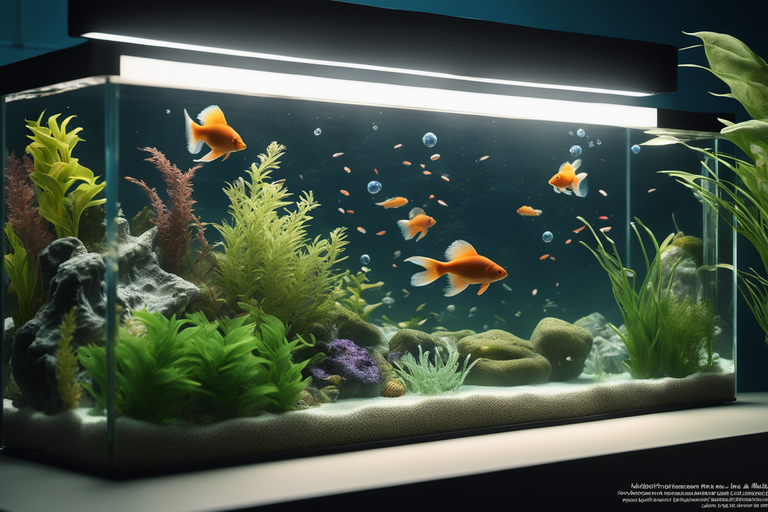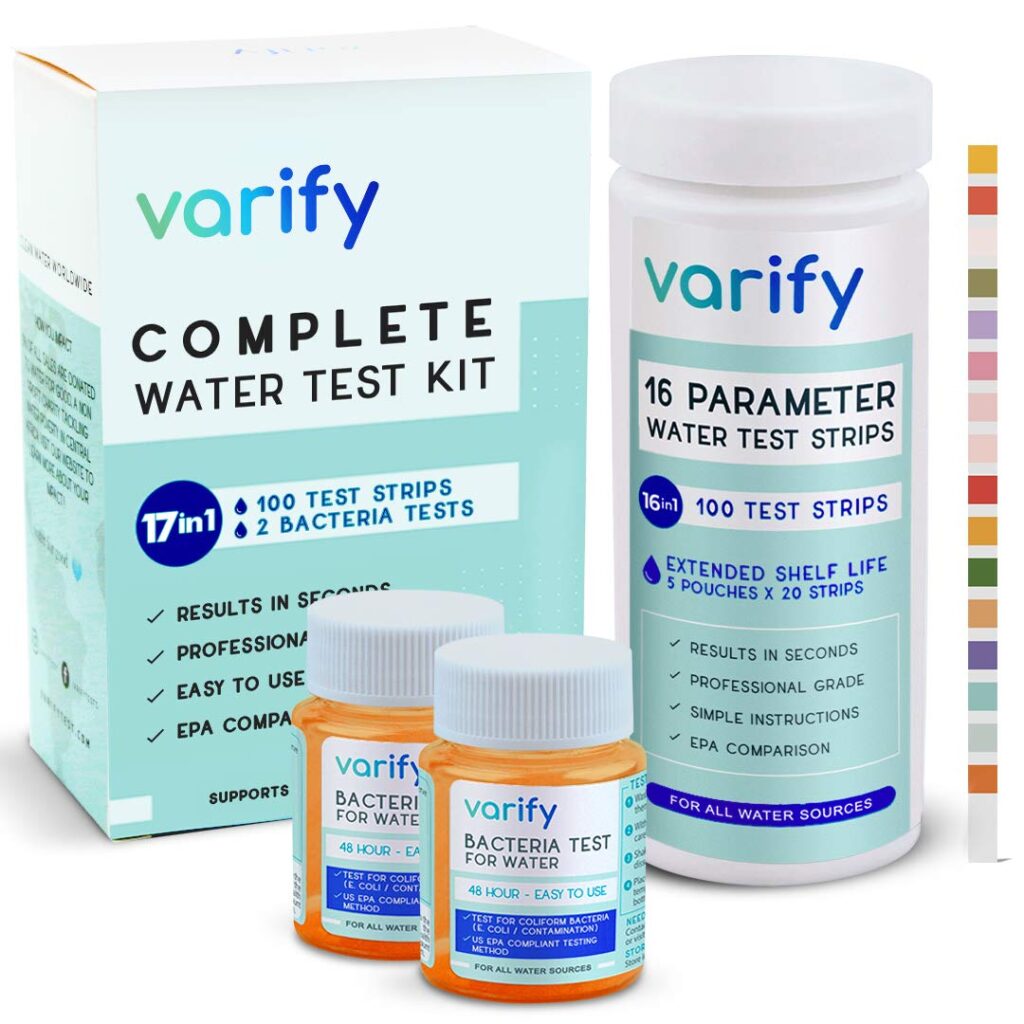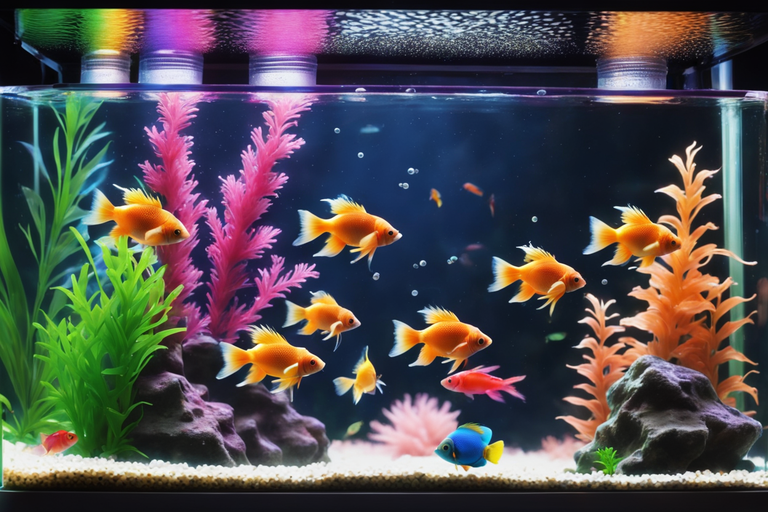Do you want to have a healthy and thriving aquarium? By mastering water quality through regular water changes, you can set up your aquarium for success.
Learn about the tools and techniques for water changes, the importance of filtration systems, and regular testing and monitoring.
Plus, get additional tips for a healthy aquarium.
Let’s get started!
Introduction
@ Midjourney AI Image Prompt: /imagine prompt:An image of a hand delicately pouring a steady stream of clear, sparkling water into an aquarium with healthy, vibrant fish swimming around. –v 5.2 –ar 16:9
Having a healthy aquarium is essential for ensuring the well-being of your fish and other aquatic life. Regular water changes are a key factor in maintaining water quality and achieving a balanced and healthy environment for your aquatic inhabitants.
With the right knowledge and techniques, you can master water quality to create a thriving aquarium.
Importance of a Healthy Aquarium
Knowing the importance of a healthy aquarium is essential for anyone looking to keep aquatic life in their home. Regular water changes can have a significant impact on the biodiversity of an aquarium, as well as the water chemistry. They also help to maintain filtration systems, water parameters, and fish health.
Furthermore, water changes are essential for algae control, water clarity, oxygen levels, and nutrient cycling. They play a crucial role in creating an environment for beneficial bacteria to thrive.
When done correctly, water changes can help to create a healthy and balanced aquatic environment.
The central role of regular water changes
You should regularly and consistently perform water changes to maintain a healthy aquarium. Water changes offer numerous benefits to aquarium inhabitants, such as improved water quality and increased oxygen levels. Additionally, they’re an effective way to control the levels of nitrates and phosphates in your tank, as well as to eliminate harmful toxins.
When it comes to water change frequency, the most important factor to consider is the size of your tank. Generally, you should perform a water change at least once every two weeks. When doing a water change, it’s important to use the correct technique and equipment to ensure the process is successful. You should also create a water change schedule to stay consistent and avoid making mistakes.
Moreover, it’s important to be aware of the importance of water changes and to understand how often they should be done to ensure the effectiveness of the process. Ultimately, water changes are essential to maintaining a healthy aquarium and shouldn’t be overlooked.
Understanding Water Quality

Understanding water quality is a key factor in keeping a healthy aquarium.
There are several parameters that can influence water quality and ultimately the health of the aquatic life.
It’s important to be aware of these parameters and their impact on the aquarium environment.
Key Parameters:
By regularly measuring four key parameters, you can take an active role in understanding and improving the water quality of your aquarium. Water chemistry, pH levels, alkalinity testing, and water changes are essential in this process.

| Factor | Benefits | Maintenance |
|---|---|---|
| Water Changes | Improves water quality; Helps reduce nitrate levels | Change 10-25% of the water every week or two |
| Filtration Systems | Removes debris and toxins | Replace filter media regularly; Ensure proper flow rate |
| Water Testing Kits | Monitor water parameters | Test water weekly; Adjust parameters as needed |
Impact on Aquatic Life
Maintaining water quality has a direct impact on the health of your aquarium’s aquatic life. Oxygen levels, pH balance, temperature control, nutrient levels, and algae growth can all affect the environment of the tank.
Bacterial colonies, fish behavior, plant health, water clarity, and disease prevention are all impacted by the water quality. Poor water quality can lead to stressed, diseased, or even deceased fish, and can also adversely affect the plants and other organisms in your aquarium.
By keeping a close eye on these parameters, you can create a thriving environment for your aquatic life to flourish.
Now, let’s move on to discussing how to establish a water change routine.
Establishing a Water Change Routine
Changing the water in your aquarium regularly is key to maintaining its health and clarity.
Frequency of water changes should be tailored to your tank size, stocking levels, and other factors.
Refer to a water change schedule to determine the ideal frequency for your aquarium.
Frequency of Water Changes
Establishing a water change routine is key to keeping your aquarium’s water quality in check. The optimal frequency of water changes depends on the size of the tank, the type of inhabitants, and the overall water quality. Benefits of regular water changes include diluting harmful substances and replenishing essential nutrients. Tank size considerations are important when determining how often to change the water. Inhabitants’ impact must also be taken into account, as some species produce more waste than others.
| Frequency | Reasons |
|---|---|
| Weekly | Diluting harmful substances |
| Bi-weekly | Replenishing essential nutrients |
| Monthly | Determining tank size |
| Bi-monthly | Inhabitants’ impact |
Creating a water change schedule helps ensure the best practices for successful water quality management. Water change tools, such as a siphon, and equipment, such as a bucket, are needed for the process. Additionally, the right filtration options must be considered for the tank. Lastly, testing and monitoring water quality should be done regularly to ensure optimal conditions.
Referencing Water Change Schedules:
Referencing water change schedules is essential for maintaining a healthy aquarium. Water change frequency, methods, and equipment should be considered when creating a water change routine.
Benefits such as improved water quality and clarity can be expected with proper water change techniques. Tips such as cleaning the filter media and monitoring parameters will help make a routine easier to follow.
It’s important to remember the importance of regular water changes to sustain a healthy environment for fish and other aquatic life. Water change maintenance should be regularly monitored to ensure optimal water quality.
With the right tools and knowledge, following a water change schedule is simple and can be extremely rewarding.
Tools and Techniques for Water Changes
Performing regular water changes is an important part of promoting the health of your aquarium.
To do so effectively, you’ll need the right tools and techniques.
In this section, we’ll discuss the essential equipment you’ll need and some effective techniques to get the job done.
Essential Equipment
You’ll need essential equipment and techniques to perform regular water changes for a healthy aquarium. Equipment selection, proper maintenance, water circulation, temperature control, water quality testing, and water change schedule are all important aspects of water change. To help with this, a gravel vacuuming, water conditioner usage, and siphoning technique should all be used. Additionally, algae control should be monitored. A table can be used to highlight these key elements, as seen below:
| Equipment | Maintenance | Control |
|---|---|---|
| Gravel vacuuming | Cleaning | Algae |
| Water conditioner usage | Testing | Temp. |
| Siphoning technique | Scheduling | Circ. |
| Water quality testing | Quality |
Effective Techniques:
By following these simple steps, you can easily master the tools and techniques necessary for successful water changes.
First, you’ll need to ensure that you have all the essential equipment, such as a filtration system, water testing and monitoring equipment, and the necessary tools to perform water changes.
Next, you’ll need to establish a water change routine and frequency. This will depend on the size of your tank, the number of fish, and the water parameters you’re trying to maintain.
Once you have the routine and frequency established, you can put together a water change schedule and stick to it.
Lastly, when it comes to water changes, proper technique is key. Make sure to remove the correct amount of water, use freshwater that’s the same temperature and pH as the tank water, and add the new water slowly.
Filtration Systems

Filtration systems are an important tool for maintaining water quality in aquariums. There are several types of filters available, from simple mechanical filters to more advanced biological filters.
Mechanical filters are especially important for removing debris and waste from the water, ensuring that the tank remains clean and healthy.
Types of Filters:
You can master water quality in your aquarium by using different types of filtration systems. There are four main types of filtration: biological, chemical, mechanical, and UV sterilizers.
*Biological Filtration:
- Canister filters
- Sponge filters
*Chemical Filtration:
- Power filters
- Undergravel filters
*Mechanical Filtration:
- Protein skimmers
- UV sterilizers
Biological filtration helps to reduce the level of ammonia and nitrites in the water. Chemical filtration removes debris and pollutants from the water. Mechanical filtration helps to remove suspended particles from the water. And UV sterilizers help to kill bacteria and other microorganisms.
Each type of filter has its own unique advantages and can be used to improve your aquarium’s water quality.
Importance of Mechanical Filtration:
By regularly using mechanical filtration systems, you can help keep your aquarium’s water quality at its peak. Mechanical filtration uses filter media to remove small debris, particles, and other pollutants from the water, resulting in improved water clarity. It also helps to remove solid waste and manage bacteria growth, both of which are essential for maintaining aquarium health.
The filter media also helps to increase water flow, which is important for oxygenating the water and providing essential water circulation. The maintenance requirements are minimal, making mechanical filtration an ideal method for managing your aquarium’s water quality.
With regular maintenance, mechanical filtration can help ensure that your aquarium remains healthy and that your tank stays crystal clear.
Regular Testing and Monitoring

Testing and monitoring the water in your aquarium is an important step in maintaining healthy water quality.
Testing kits are available to measure levels of nitrates, ammonia, and phosphates, which are key indicators of water health.
Testing Kits:
By regularly testing and monitoring your aquarium water with reliable testing kits, you can better master the quality of your water and ensure a healthy aquarium. Testing kits provide you with a comprehensive water quality analysis, including:
- Test result interpretation
- Troubleshooting water issues
- Chemical testing methods
- Testing frequency
- Accuracy of testing kits
- Comparison of different testing kits
- Benefits of regular water testing
- Understanding water parameters
Testing kits are essential for successful aquarium care, giving you the necessary information to make informed decisions and keep your tank in optimal condition.
Monitoring Nitrate, Ammonia, and Phosphate Levels:
Regularly testing and monitoring your aquarium’s nitrate, ammonia, and phosphate levels is essential to mastering water quality and keeping your tank healthy. Nitrate reduction is key in maintaining a healthy aquatic ecosystem, as too high levels can lead to algae blooms.
Ammonia toxicity should also be monitored, as it can cause fish stress and even death. Phosphate control should be a priority, as this nutrient can lead to an imbalance in the aquatic ecosystem, resulting in poor water clarity.
Regularly monitoring and testing for water parameter fluctuations is important to ensure a balanced aquatic ecosystem, as well as to maintain healthy biological filtration and fish health. If these parameters aren’t monitored and tested, it can lead to nutrient imbalances, algae blooms, and fish stress, all of which can adversely affect water quality and the health of your aquarium.
Additional Tips for a Healthy Aquarium

You can further ensure the health of your aquarium by making careful choices in the types of aquatic plants and fish you introduce. This will help ensure that your aquarium remains healthy and well balanced.
Additionally, following a consistent cleaning and maintenance routine is crucial. Regularly cleaning the tank, removing any debris or uneaten food, and checking the water parameters will help maintain a healthy environment for your aquatic plants and fish.
Choice of Aquatic Plants and Fish:
Choose aquatic plants and fish wisely to ensure a healthy aquarium.
When selecting plants and fish for your aquarium, there are many factors to consider. Aquatic plant selection must take into account lighting requirements, nutrient supplementation, water temperature, pH levels, substrate choice, and water hardness.
Fish compatibility and algae control are also important, as is oxygenation techniques to keep the water oxygenated.
Finally, the selection should also include fish that are suitable for the size and type of aquarium. With careful consideration of all these elements, your aquarium can remain healthy and balanced.
To maintain this balance, be sure to create a cleaning and maintenance routine.
Cleaning and Maintenance Routine:
By regularly maintaining and cleaning your aquarium, you can ensure a healthier environment for its inhabitants. Cleaning techniques such as vacuuming the substrate and cleaning decorations help maintain the aquarium’s cleanliness. Substrate maintenance, such as removing uneaten food and debris, is also important for keeping the water quality in check.
Additionally, cleaning decorations and controlling algae growth are also important for maintaining the overall health of the aquarium. The benefits of regular water changes can’t be overstated, as they help improve the water quality indicators, as well as the health of the fish. Furthermore, when performing water changes, it’s essential to maintain the proper water chemistry.
Regular filtration methods are also key to ensuring a healthy aquarium, as they help to remove unwanted substances from the water. Cleaning and maintenance are essential for the overall cleanliness and health of an aquarium. As such, it’s important to follow a routine for regular cleaning and maintenance to uphold the water quality. This will in turn lead to a healthier environment for its inhabitants.
With these tips in mind, you can easily transition into the section about the conclusion.
Conclusion
Now that you know the importance of regular water changes and proper water quality for a healthy aquarium, you can confidently go forth and master this important task.
Taking the time to make sure your aquarium is well maintained is essential to creating and sustaining a thriving, vibrant ecosystem.
Congratulations on taking the steps necessary to ensure your aquarium’s success!
Recap of Key Points:
Overall, it’s clear that regular water changes are essential to maintain a healthy and thriving aquarium. It’s important to understand the parameters that should be monitored in order to ensure the water quality is suitable for the inhabitants. The frequency of water changes and the scheduling of them should be taken into account when setting up an aquarium.
Water change tools should be collected before beginning, as well as the necessary filtration systems. Mechanical filtration is an effective way to remove solid material from the water, and testing kits should also be used to monitor nitrate, ammonia, and phosphate levels.
Encouragement to Maintain Good Water Quality for a Thriving Aquarium:
Now that you understand the importance of regular water changes for maintaining a healthy aquarium environment, it’s time to take action and ensure the water quality in your tank stays optimal. Proper oxygenation, temperature control, beneficial bacteria, and controlling algae growth all play a role in keeping your aquarium water balanced. Water quality testing and water changes provide many benefits, including keeping aquarium water parameters in check. Additionally, it is important to maintain proper feeding habits, water circulation, and observe fish behavior to ensure a thriving environment. Remember, these steps are vital for a successful aquarium. So take the time to make sure your tank is healthy and thriving!
| Role of Oxygenation | Preventing Algae Growth |
|---|---|
| Water Temperature Control | Beneficial Bacteria |
| Water Quality Testing | Water Change Benefits |
| Aquarium Water Parameters | Proper Feeding Habits |
| Aquarium Water Circulation | Fish Behavior Observation |

